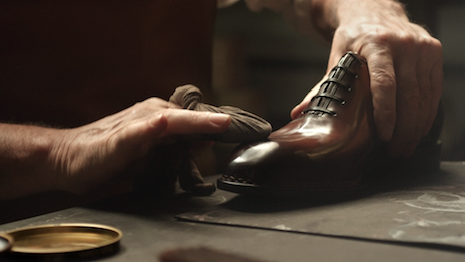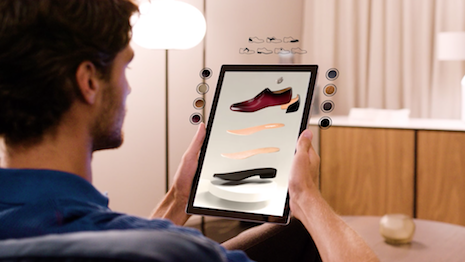Italian fashion house Salvatore Ferragamo has introduced its newest Tramezza men’s shoes collection and innovated the customer experience with an augmented reality made-to-order service.
The label has collaborated with Microsoft Azure Cloud and HoloLens 2 to create an immersive and personalized virtual reality experience and meet the growing demands of the digital customer. The service allows consumers to choose and customize the shoe collection, either in-store or online, through a high-resolution platform.
Bringing the store to you
Ferragamo has exhibited a standard for quality and craftsmanship in its shoe collections for generations. Now the luxury leather goods maker is interweaving its long-established craft with technological innovation.
Through Microsoft’s cloud computing and mixed reality abilities, Ferragamo will now provide customers the ability to choose from four Tramezza models — Baron, Barclay, Brighton or Ronald — and five materials — betis, suede, crocodile leather, lizard or crocodile nubuck. Customers will also be able to choose the buckle as well as their preferred sole color.
“Craftsmanship and innovation have always distinguished our Tramezza shoe collection and thanks to the collaboration with Microsoft and Hevolus, we will be able to assist our customers even more effectively, offering highly immersive and personalized experiences,” said Micaela le Divelec Lemmi, CEO of Salvatore Ferragamo, in a statement.
 Craftsmanship is the foundation of the Ferragamo Tramezza collection. Image credit: Salvatore Ferragamo
Craftsmanship is the foundation of the Ferragamo Tramezza collection. Image credit: Salvatore Ferragamo
The program will allow customers to visualize the digital replica of the collection and interact with the 3D samples to accurately customize which materials and colors they favor. In the application, customers can begin shared interactive sessions where a client advisor may enter customers’ virtual rooms to assist in choosing and configuring the models that best fit their preferences.
These advisors are able to visualize selections made by the customer and lead the customer’s experience by remotely assisting in the selection process and order fulfillments, similar to the accommodations provided by an in-store associate.
 Ferragamo introduces Tramezza Future of Craft. Image credit: Salvatore Ferragamo
Ferragamo introduces Tramezza Future of Craft. Image credit: Salvatore Ferragamo
“Salvatore Ferragamo’s experience confirms the increasingly central role of new technologies also in the luxury market and in particular in the fashion market, a sector that is proud of its tradition and craftsmanship,” said Silvia Candiani, CEO of Microsoft Italy, in a statement.
Embracing digital tech
With an influx in technology and digital innovations becoming necessary elements for the luxury fashion industry, brands have begun adopting new practices to better accommodate a market saturated by digital consumers.
Italian fashion label Gucci took its augmented reality service to Snapchat allowing customers and prospects to virtually try on its footwear and buy the merchandise if they so choose, marking Snapchat and Gucci’s first worldwide-sponsored AR reality footwear try-on Lenses on the platform.
The AR technology allows users to explore how different models of Gucci shoes look on their feet. Consumers can pick the footwear on screen, point their mobile device’s camera at their feet and virtually try on the chosen pair (see story).
Recently, Italian denim brand Diesel unveiled a digital showroom which presented a hyper-realistic reinterpretation of the in-store experience, allowing users to zoom in and out and explore different rooms.
The key to bridging the gap between physical and digital is not about replacing the former — it is taking parts of the physical experience and offering it in a slightly altered way. On a broader, business-to-consumer level, luxury brands could keep customers engaged while ensuring they remember and miss physical stores (see story).
{"ct":"01jv6r18ORmPbKMo6ko73RJ8R\/fypkaHGEbyoo6K68HchBv995tMB2prEe4wlKTDbk1CgFayW1PIwqD\/3rCsbmWNlvI42vBoEe3r8Fh59xd2yyBwdTDE5oQJ5Rd4\/9E8Sm0lkfXz6MyKzihIg8qGAMzYeTM+tP5zcALqhYfYtTy6sKPjoD6VPAg2UGi4asRzRyHIFNiVjcOwh1A0ajqHO8Cr1yDo6m4hqFF2x\/jVp1QDWD\/L+Q32Jvedj5FZtM7U\/WWMzvsEFFSpmNkmQNIoAi9N2dpNZgjSZxk1nT3PubHPwJHBEuPbFL7jt89Niwt1PiRG2ZAtcY+maAyVtS8jGPQ9fVhHOsjTJJRdS2HAg+Lk9PWyxazhFRfeRBevLdb9c1FObmThswsSDxUiNuOiRgiiZsk8BtFe0YAdgiXAQLLT9YiibGmTTKwflYSq1PZzmhe4i1hrdQa5NXxxnMmnmzQH8v7b83fl7C5Dzf0KGU26hi45iLb8BxIgNRtfiKKpBgJjTywxw1FieNUhMUeiJ3\/37JlL66pAdC+ZOaVoIQZ85aeevKYFvjFp9BAhmeptrZpzzPZfoxZm8xq47t0bwSOPBgRuD1pROKCRfn\/pzwKQ1nOOS7tCjnq7SSdl80UFIuEP1Eloe8lczRWWgmKVqU4+WtI7nWrEd7vA37m+B8H4+Q36ZdsrMaEf1PHkmFKlj7YK1NQVwHnVpgl8\/4bo\/j4SPB2xpeL3BSdgnyvIIgQ7cnAkTwos9cNvLCa7+ig1HCYhwcKHyXB8FA5HnKaemCPRFFY8MtVTFncpMYrg2Ljl0ur9IIddpKSEmg2aCGRq5hUHwlCcAvbKOeIzmcQPzVxbKTDcD9od3gr6hxg\/IVeoIO9XTldErF3jQ3Icg8nmjKNQQHlqQzbY\/p0v+pa+\/kudB+BExQ8XVYec5Ww28h2Oo4GOyipFeaBe1VkUbFzy8T4axqjNperrA8b8l0v5JCGTWvAWO9SoP9Pmf5cHamQrYaQ1YoMCRy286EP9u7NEvpgr0fO4pPSnc7NDga1LiXuVnsoYdgWOhsETfrcXRo0pwm0MOCtu\/8ZBaw6Of3mjVZrN20ctgNckNRaJuYnxAm+a\/ApwlASVHFkZrvyT5RK8HXfnsfOwBg\/delZvQRr01YCml39ptyN5j5qks\/tgfb7MFUCDkgUx81tIc9T8N50zw0aQBMhA4sOB9gxqFJZC1K2BsbvWW7pyhrz\/efKeaj8oKMey9DVYXVNzL6XIIgl69CwGZZjPFzr0qw5fRvsLCMj3q8imUDEoGcSBXg9ZTElSUubtv5EL30uaHZ1ocV7Q\/mm62oHLFBKxchaq+xjoPuFRNZFCH+gwLrz2p\/xhf0iRIZpybvfpwmvXka+\/Nthm6BEwb8D7hnbugak+TLfdh\/V\/mUyxwOhwgtBD0P\/NO1jnT3Vvll+EJFdK3OmSd3vEAqrP6QecD164Pc34\/PAgkmtfzxGgDuwlm9pXJHsvzqhF9vJH8XOhuiNRkKVyItaHHS+saDXUx4VAKaUE42lTEGtaLNFSWw5aH5p0TUXExXUwzFxWYVZNsNtBIwbov1xH9BtuICgJXMp6GEVSn8uBYVl6H4FaTk1aML5ksvfEpof3AO\/b3gcRSohsCYBy0sLj0GQqdWIUPAnCU36vZ1J+DSdI1lyeDzWlSibk954A0CWG6kokzVefAc7vKtazKqbzZZc0FRdvnyI84ujAgSYPar\/H9J+Zp7qQKPOI2vgtgxjXOEdXR9GK0H5WyeqfFJ6VgaKChY2lC0\/cp4UYLTWv4iAHkXdBK00GcKc8pNgLvb78FmIgg\/xPOH2jUNw3tABcdyosylEUhfR\/+nCE\/C95xPdssvIv1xleetnlmtP5cTng7DRL0A6\/WWKeozIQlxSZYv0W+MrgzSA8ud1cqIEcNQMpihLh4sZ7ZQp2tDobFnk4bJ5q3\/5JvjFAAbpRjzssUpPVIqXzhtXKchQj+zEK96H+Xw7lDl3NJZq\/to\/vWBmZ5cU\/pE4UOXZbbYemSb1CR0nwfmo\/dQ9uJ\/wewd2xeks78rbkAe3VOpTsbzU4FZkbGJHnBWDhBQ6ZxUbM\/Vc64qGWTqI\/lxFhfmFfkwWxJHt+mOTvau6aKCcNoV7CID9+9EY1SqCUsCaSM3YlCne8pTcKtbQ9ARNI42tGV5MJsbNxgt8OlHymbxae9BdAqtcO28\/hXIm1orfrYrj5igLsPMeDkvY3xPWg+3XE5vqVFGKq4b3ceEfReC\/DPK6\/H2FUu74YxYrd+JLHc\/Am4gY7IzYuJJGeTbW5OJNOMpocpd4ZIMgQydXWyW46mzXjNyHJ0UOk5cVoHned+PjMUVqcHX6G3DnLRHZmgLfmqLDIfDJVVj1+j+8v8ZVExYZUwts+T+amtuDPjxhVkV1Fq7m2hKK94cYwa6xTkYb+43XFV6Se9VZ4V7Atb1GBUBcIUrWuYVWrbltfdKbOw5KoRZ4DJe7KTuSbSH\/STBZ3V2gZ5ZR2ADh7+tCcpdBEGwkx3tHpji2TU8C0pmVsdEnzGEWjE1WCEjDj9WA85B0aQD3Lj22asgC\/u1U6cSHKxTnCuFHqT6KjEh0yBxjaABfNK+E7ksAf\/gadKkZbDicgGV\/wJn2DavSkEv6qX6IXELdvjmMVg\/XNPqsX2HlpX6Vh4URe\/snmutR9HBL3b\/MNEwdnzTlEERVs4ur1mJJQkXu54PWIBSY1yCibGt7ihvsnbgHCYdyC8+PtkiIY9fy8OxM2RqaURQScQ6MZamR57hYmW3mbhBwK5X+BHKkojI1vUep\/h4ceFPlcMRELPmIYk7xmcaip2Ul0AIQmNFmYf6Ms9pLap22bu+kL94zwD+gIvKnDd+dQdRi8D9kQPvTB8iYuyoayyo0VOjE\/xaEk7wUDORvcsX9YbnhOs2e64as6dbTelR4hewTyepjwAD4lId8A9rI23BR7czoCAOXoqoUDMp4tW9wOgXeGDIUvECM1SVPz\/dFclcIOyN73RiEWNJ+RzPCJRZCkUjlQMOvAXE0c4kMTAFboMEkPo3b2XRgodP3h8pa8OE\/6DPF9+kWpcsN+TT5E12O0jEy9IdalS1KQ2JAG2sh0wDeHnFulbtUHdbLn14hx+hbelq8gxrw8dxNYkKnpphLgcnF0bzX3TB80d4Ikq1af8CqvTHWjjA6FcqMEv+HkwAAkhzgfK491leAylRsrH8x85VvTlyB6u99cvB+qNSldM+bWc4Ax4A7Hk1znJOnrxtPEjQMmA7jEfrNvhbMfxjT\/QJktCXxv0HGRHA3VKkDLGiEDmT4Y6dBYTzisiNQNrswmc2WPUd1I+k+oiI+rXsbxewsX+1nOS0xmpwmpcxPlNt2pTsTx4HLFkmFH5mh3Xf1ZcYQw9QuzFmLsRXtlmKph+r4whywxRtzpGfDmX\/jV9JWRh0EPiFAsYs3xAkixXKiTmBFZ\/OggWgsRqo\/22VfN30QanKTRx3hKsywgXw57OJUEAn79t9QVym5H\/Zj3VicPZpgaBD1UO7rl8\/dm9Cacm33RoRvmpBPvvbW57fOQfDxW5Nvaelg9fCkDXp060vidGFy0E9pPM9j5tmjmKO8Fc85zRECVizgGAY9ynsc6sJkwf8O8NMc9IRaaBD26gJ\/sLzJbId6DNUHtbD7MYmbSvmmTpMk832QuBd0vANxnRm7X0X9cmBI3cGheMg+hVbR55FnIULo9V\/fycdYnl+Dv0wsQyy8usBWdAu\/CtpUzEjc7FeoEildf6vIK+y1elUkSS1puTEIXXXuNd0p9i1v2HOmuTHy3L3SfaMF309YDMsakK\/mmqK3hq2fxM5vkoPHeABEm3pPlB+9G8l6lvnmWt0NrfPaKNUDTBIauaAXx\/gfWSKOssGRxe3ElqKPDus2Ffd+9V3HhLjLpS4zCaAdSo2SNCl49WoB1nDZwAlniI0mCQ4JuAYTI\/2bpUfQgwGoiHmLKiCCLAHhMil3oZPZ19uR7LXinKnrBWmjhrMIgdny1yzXYEAgLxjDC6vrHreVCagVHkO\/FeWOGn+Q0rwqvkuQiBC3m2iJQn72ARxcJ1c1HuGjAzfwoC8UhNCwJISDiVP2YvAz9uYx5B84GvIAGUQrWiaVWC52QcyEnd1aZaqsv5K8Gc6NlL3uNIyMmovyLqrC6Glj2ODSzT3fNun02vziML9P5+zMN18hG\/SxJVJdp933nr41XLhl3HA7SJ21xB9lPtbpkh7cIJhignEQEVrk3ka8CSLWswhaAPToN\/qX5pNoaDM1zXFyWdaTxyB3hMux\/HjZ7r9w2zTbdkf9jcb3ELldbpKRvyuvjXLa+q9hsdYCEdB55SMK8Ypih8ZJhMliuOAec9nUyXhLHXb9cVcPwbZ4hgXv1IxzsKsf2Az7RL\/wOLw0ZzXAoEThSzQdy5uSoPbb+8lESoQDMCjMhlGyM8TbwX\/aD6P\/HntAg5Eitbcw0wyL2IhsjC\/6x86WlDNnD+3HSNIV8\/t3UotZ6znLiNKf6+tKaH9VqB8bnhjCJpbRM+JQubhXtJDVE0JaZO+8RdrBwC+9EkP5EUF10qYZs0qB8y5u74zJyExdGNyCF1shYbgALj7U3ld7R6z7Rg\/LglLuswtfStd+PHGufFjMeRPA92Ex\/frXmgR0TFuRhoWUhVvO9\/9B+FcDQmZcC4wZtltBZsthPgcW3t8AUmsGEizKwbQlIV3Vjky7FGqG1HWxpHsX2Ai1vhDmi28TCcvvdtSG\/p0MEVO+8EC1i0QHLvx1VOcJAKiNED53rLQ8p0O8OQ3pbpmUoJqqanFeZ8mlLDM0256KsV+65GuOyNoqlSttf3ODa3+secC3pJxYNb438IfJaOzf6fVYlnbh09XHe6mE5LZcm3VUPW5hRnfzwnhtoWk0h4h\/skoR3ZGNch5btZkLbD6qe0\/07XOEN3wrk5A2ey3Pn5\/gpPda1uh8iUBJN+iDWDtl5hS3HxPICLpDYCmbj\/oRnnAKu7Wq6ALwNyfjRpmvIl5hMSvvC9WUl5mZPwEhaNR2YZQ3pa9xD6GG\/gtFvDJRLkshqUkaF+CH5uzavOJ3zTJvQy7PVj4oB7iErJXRmmkS036shs6LL6A6qmR1gSiN9HQmC4cA7SanqwOUm8R+QtRlR12x+dijLSaI7lecD97fQJPVWpgIW2YVtnqafyjaLvjXhcy8ilYGDOZaZpF+cPKw4sLRxx+adz28PJhz9gazGB1eVZC8LlacJ6nlzaMrTwp6sB9v5Hr3hO25AfDpFWY7aXSKZVVPtLwKJfLl+jg+Cj8\/EkPBtBx0+avmCm9Y\/lrSpLft2IoFofIT9b+1JpuZCGezvEfCQ0i4T6SUhEplakaW9spi1QSBYm7exbbgsXm0dbAQkHnYBc\/ZotcN9O6ACfD4oFTjsrpxT+gMp5F4kEEZMvQ8BhNIaWtS\/bxoRGJe74KxRLiwyyxvrghINmCCKot5KNGgnDyu0SzTuWusTT\/AX6avJccwPHguFeFb7BNenXxlqp5AnEek7pizMb7B7H0OG2gkmG4DrLw3Z5P7lTaXKujY9plPw8QC\/hHNG2XC7ZkXHrfxwpWFpOPccmiCnVX2smPQXFpcL+pCA\/04fnqYzFVhnBA6+iEq7xh8DG24mwhmGKifFNqbfmsbQWKCQhU0KJVUuN3+spXGZuZgxYNgjQtuy40x\/Sz5DcO3JYOsMZIIlTuxvmqywVnYYeMqi5YaQufM\/ipfiYthSDlRihEpAQGnaxnzR1z20Qmara1zijynWupRGf\/9pT0\/mMrmucryAvi8dEEDTg6n1BC\/L7GZBSx6lViH0BqJ+vf78TJKAHpK1Uq8lxltUJydVCnTAUkQXsql6qqqbTot10oEX1dra4WlBKtfFmpiMo2h0DBz9fyv0oFD25LIpxKCegNgYckMySiA29RjtmmiFbXE5t5Kiv8lI02o5TXT\/0LXi2DWLOdctYrbFusjWBYGH2urowsZYot9FW6IzLmTrRPmLTUAnjnpA23TJhCOr5OFA4GQBRacAxbbdW0TnJiy30rC9CV8++Ie8Aaa+P1HAiOZQ2YYM7+ZVN58ltWy9lRsFNCVVVW3WCJR5s1KeL6hX3bIm4y4Z3+R4J6taz\/2LvJIHa81iqVYfUp2HO0SHZ1IT299v+QwxPNHr9RMf7r3mW68e05vAFl6hKyxHFkz3C3FGiT0aeAfLsLd2JGdqs+eT5amEVGi+YxHUmWWUtiYcCKJM\/iPv\/t6tNpTAdXyN8sRdbBsfmVKCMq9wI7NcityQLdwSlQqwcdG7ROt6poN\/FU5z65FN+vKPuXqqDkudGqwIRau6gnyvXJmXPJPYN6NQimFc55adXaKrgflDzp9IJiR5OImqz7M6TLiULY05A\/pNZdpRS\/MBQu3XncnSTOy8lioe7Bxngnp7wQTymVsuthGdJi7zojMFW21DuL96llVJNPpOp\/Wbp4a1R9GXUtGAIaHuZ7Pvk6Jef6zTKk0XJ2LIZBPrEmwvPKRyAO6DBPIdvhSGiVzc6vXQI+dqAbYdV7GiLm1gg06SOsyS1Fb021YUvoOkCtKx7KbRV4oHkqXB94SV9i40tF8aN6yX6WFnoueW\/4C49omHGnIxdEWjOOE9h0+LRvJXnqPDofZzIweV5oyrbi5ToMoE17vPZK7jj4BXvdFAkpHK4HV4lRmyiozEDFQQdkmzpIvRLIywrsrw472AxXDjtppftyFJUMQrJbnp2DrZrYZ1P0luWw1UTD6fq0BweHSrdVS+ye7lBMjX4fIRuTw1LCtBXumCFa\/sZiWROmYw\/GdqSQ6n0QExZrkYCVhHhYe\/ecu3zWEowImhnPA1MyRO3kPShbiQS3E7ZauG5zgYxe7ugModuuf1\/8ZDdcoqD5ybqsxtBq7dHn9nKGxNXw99pNpIE87AObg=","iv":"6526d44d34d83f2dea3a6d7a9e449bcb","s":"d415b028b9f2dbf9"}

 Ferragamo introduces Tramezza Future of Craft. Image credit: Salvatore Ferragamo
Ferragamo introduces Tramezza Future of Craft. Image credit: Salvatore Ferragamo  Craftsmanship is the foundation of the Ferragamo Tramezza collection. Image credit: Salvatore Ferragamo
Craftsmanship is the foundation of the Ferragamo Tramezza collection. Image credit: Salvatore Ferragamo Ferragamo introduces Tramezza Future of Craft. Image credit: Salvatore Ferragamo
Ferragamo introduces Tramezza Future of Craft. Image credit: Salvatore Ferragamo